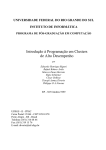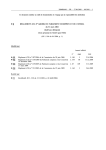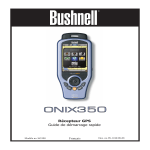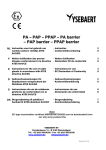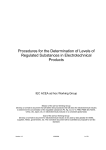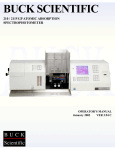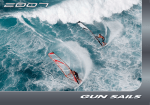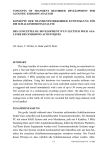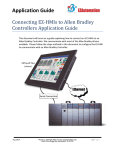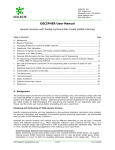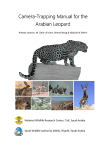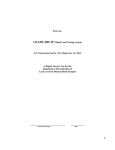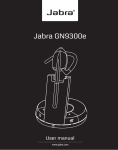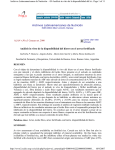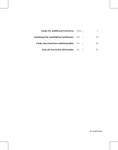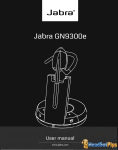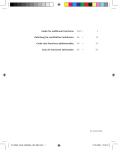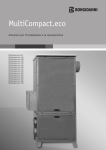Download Methods for the Determination of Metals in Wildlife Tissues Using
Transcript
Methods for the Determination of Metals in Wildlife Tissues Using Various Atomic Absorption Spectrophotometry Techniques E.A. Neugebauer, G.L. Sans Cartier and B.J. Wakeford National Wildlife Research Centre 2000 Canadian Wildlife Service Environmental Conservation Branch Technical Report Series Number 337 TECHNICAL REPORT SERIES CANADIAN WILDLIFE SERVICE This series of reports, established in 1986, contains technical and scientific information from projects of the Canadian Wildlife Service. The reports are intended to make available material that either is of interest to a limited audience or is too extensive to be accommodated in scientific journals or in existing CWS series. Demand for these Technical Reports is usually confined to specialists in the fields concerned. Consequently, they are produced regionally and in small quantities; they can be obtained only from the address given on the back of the title page. However, they are numbered nationally. The recommended citation appears on the title page. Technical Reports are available in CWS libraries and are listed in the catalogue of the National Library of Canada in scientific libraries across Canada. They are printed in the official language chosen by the author to meet the language preference of the likely audience, with a résumé in the second official language. To determine whether there is significant demand for making the reports available in the second official language, CWS invites users to specify their official language preference. Requests for Technical Reports in the second official language should be sent to the address on the back of the title page. SÉRIE DE RAPPORTS TECHNIQUES DU SERVICE CANADIEN DE LA FAUNE Cette série de rapports donnant des informations scientifiques et techniques sur les projets du Service canadien de la faune (SCF) a démarré en 1986. L'objet de ces rapports est de promouvoir la diffusion d'études s'adressant à un public restreint ou trop volumineuses pour paraître dans une revue scientifique ou l'une des séries du SCF. Ordinairement, seuls les spécialistes des sujets traités demandent ces rapports techniques. Ces documents ne sont donc produits qu'à l'échelon régional et en quantités limitées; ils ne peuvent être obtenus qu'à l'adresse figurant au dos de la page titre. Cependant, leur numérotage est effectué à l'échelle nationale. La citation recommandée apparaît à la page titre. Ces rapports se trouvent dans les bibliothèques du SCF et figurent aussi dans la liste de la Bibliothèque nationale du Canada utilisée dans les principales bibliothèques scientifiques du Canada. Ils sont publiés dans la langue officielle choisie par l'auteur en fonction du public visé, avec un résumé dans la deuxième langue officielle. En vue de déterminer si la demande est suffisamment importante pour produire ces rapports dans la deuxième langue officielle, le SCF invite les usagers à lui indiquer leur langue officielle préférée. Il faut envoyer les demandes de rapports techniques dans la deuxième langue officielle à l'adresse indiquée au verso de la page titre. METHODS FOR THE DETERMINATION OF METALS IN WILDLIFE TISSUES USING VARIOUS ATOMIC ABSORPTION SPECTROPHOTOMETRY TECHNIQUES E.A. Neugebauer, G.L. Sans Cartier and B.J. Wakeford National Wildlife Research Centre Canadian Wildlife Service Environment Canada Technical Report Series No. 337 Headquarters 2000 Canadian Wildlife Service Issued under the Authority of the Minister of Environment Canadian Wildlife Service © Minister of Public Works and Government Services Canada 2000 Catalogue No. CW69-5/337E ISBN 0-662-28024-5 Copies may be obtained from: Canadian Wildlife Service National Wildlife Research Centre 100 Gamelin Blvd. Hull, Québec, Canada K1A 0H3 This report may be cited as: Neugebauer, E.A., Sans Cartier, G.L. and Wakeford, B.J. (2000) Methods for the Determination of Metals in Wildlife Tissues Using Various Atomic Absorption Spectrophotometry Techniques. Technical Report Series No. 337E. Canadian Wildlife Service, Headquarters, Hull, Québec, Canada. PREFACE The Laboratory Services Section of the National Wildlife Research Centre (NWRC) has been providing analytical determinations of trace metals in wildlife tissues since 1990, to collect data for research projects associated with the National Wildlife Toxicology Program. Although the methods used are already available in the open literature (references listed in Section 2 of each method), this technical report has been prepared to describe in greater detail the analytical procedures and the quality control system developed in our organization, in order to ensure that the procedures are conducted in a standard and reproducible fashion and to ensure that the researchers, using the data, are well informed of the adopted methodology. There are four methods included, written in a format consistent with the CAN/CSA-Z753-94 standard (Guidelines for the Documentation of Test Methods) which in turn is based on recommendations described by the International Standards Organization (ISO) Guide 25. Method MET-CHEM-AA-01 describes the technique of analysis for a number of metals using flame atomic absorption spectrophotometry and method METCHEM-AA-02 describes analyses of the same metals but using graphite furnace atomic absorption spectrophotometry. Methods MET-CHEM-AA-03 and 04 describe the techniques for the determination of total mercury and organic mercury respectively, by cold vapor generation atomic absorption spectrophotometry. It should be noted that some sections of the methods somewhat overlap and internal referencing is therefore used to minimize redundancy. Standard Operating Procedures (SOPs) specific to our organization, cited throughout this document, are available on request from the authors. The names of manufacturers, suppliers and trade names are included only to document the exact assay conditions adopted by the Laboratory. Other equivalent products, instruments or reagents from other sources may also give satisfactory results. i PRÉFACE Méthodes pour l’analyse des métaux dans des tissus d’espèces sauvages par différentes techniques de spectrométrie d’absorption atomique. Depuis 1990 la Section des services de laboratoire du Centre national de la recherche faunique fournit des résultats d’analyse de traces de métaux, dans des tissus d’espèces sauvages, pour appuyer les projets de recherche du Programme national de surveillance des effets des produits toxiques sur les espèces sauvages. Bien que les méthodes utilisées soient disponibles dans la littérature (références incluses dans la Section 2 de chacune des méthodes), ce rapport technique a été écrit dans le but de donner les détails des instructions de travail et les étapes du contrôle de qualité mis en oeuvre dans notre organisation, afin de s’assurer que les résultats y soient normalisés et que les chercheurs, utilisant ces résultats, puissent connaître les détails des méthodes adoptées. On y retrouve une compilation de quatre méthodes analytiques, rédigées selon le format proposé dans la norme CAN/CSA-Z753-94 («Guidelines for the Documentation of Test Methods»), en accord avec le Guide 25 de l’Organisation internationale de normalisation (ISO). La méthode MET-CHEM-AA-01 décrit l’analyse de divers métaux par spectrométrie d’absorption atomique à flamme tandis que la méthode MET-CHEM-AA02 décrit l’analyse de ces mêmes éléments par spectrométrie d’absorption atomique avec fournaise au graphite. Les techniques utilisées pour l’analyse du mercure total et du mercure organique dans des tissus d’espèces sauvages par spectrométrie d’absorption atomique - génération de vapeur sont détaillées dans les méthodes MET-CHEM-AA-03 et MET-CHEM-AA-04 respectivement. Il est à noter que certaines sections des méthodes se chevauchent et, afin d’éviter les répétitions, des renvois internes sont utilisés. Tout au long du document on fait référence à des modes opératoires normalisés («SOP’s») qui sont spécifiques à notre organisation. Ces procédures peuvent être obtenues en communiquant directement avec les auteurs. Le nom des manufacturiers, fournisseurs et nom de commerce des produits sont inclus uniquement dans le but de documenter les conditions d’analyse précises utilisées par le Laboratoire d’analyse des métaux. Des produits, instruments ou réactifs équivalents provenant d’autres sources peuvent aussi donner des résultats satisfaisants. ii TABLE OF CONTENTS PREFACE………………………………………………………………….……….….. i PRÉFACE …………………………………………………..….……………..………. ii TABLE OF CONTENTS…………..……………..……………………..…………..... iii ACKNOWLEDGMENTS……………………………………………………………... iv METHODS / Method for the determination of metals in wildlife tissues by flame atomic absorption spectrophotometry ……..………………………………….. 1-1 MET-CHEM-AA-01 MET-CHEM-AA-02 / Method for the determination of metals in wildlife tissues by graphite furnace atomic absorption spectrophotometry ………….……….…………. 2-1 Method for the determination of total mercury in wildlife tissues by cold vapor generation atomic absorption spectrophotometry ……….…….…..…. 3-1 MET-CHEM-AA-03 / / Method for the determination of organic mercury in wildlife tissues by cold vapor generation atomic absorption spectrophotometry …….…………..….. 4-1 MET-CHEM-AA-04 iii ACKNOWLEDGEMENTS The authors wish to thank Della Bond and Tony Scheuhammer for initial drafts of the methods that have been incorporated wherever possible into this document, and for their technical review of the manuscript. iv Chemistry Unit Laboratory Services Section, NWRC CWS Technical Report No. 337 Method No. MET-CHEM-AA-01 METHOD FOR THE DETERMINATION OF METALS IN WILDLIFE TISSUES BY FLAME ATOMIC ABSORPTION SPECTROPHOTOMETRY 1. SCOPE AND FIELD OF APPLICATION This method is applicable to the analysis of metals in wildlife tissues, such as liver, kidney, egg, etc. of avian, mammal, amphibian or reptile species. It has been applied to the analyses of cadmium, calcium, copper, iron, lead, manganese, magnesium and zinc with typical limits of detection of 0.2 to 2.0 µg per gram dry weight of a sample. Method MET-CHEM-AA-02, which is described in the next section, is used if there is a requirement for lower analytical detection limits. If analysis of mercury is required, then analytical methods MET-CHEM-AA-03 or 04 are used. 2. REFERENCES 2.1. The Perkin Elmer Corporation (1982) Analytical methods for atomic absorption spectrophotometry (equipment operation manual). 2.2. The Perkin Elmer Corporation (1983) Instructions, Model 3030 atomic absorption spectrophotometer (equipment operation manual, P-E Part No. 0933-8033). 2.3. Slavin, S., Peterson, G.E. and Lindahl, P.C. (1975) Determination of heavy metals in meats by AAS. Atomic Absorption Newsletter, 13(3), 57-59. 2.4. Kimbrough, D.E. and Wakakuwa, J. (1992) A study of the linear ranges of several acid digestion procedures. Environ. Sci. Technol., 26, 173-178. 2.5. Evans, D.W., Dodoo, D.K. and Hanson, P.J. (1993) Trace element concentrations in fish livers. Mar. Pol. Bull., 26(6), 329-334. 2.6. Stronkhorst, J., Ysebaert, T.J., Smedes, F., Meininger, P.L., Dirksen, S. and Boudewijn, T.J. (1993) Contaminants in eggs of some waterbird species from the Scheld Estuary, SW Netherlands. Mar. Pol. Bull., 26(10), 572-578. 2.7. Shrader, D. (1992) “Quality GFAA results faster than ever!” in The Eight Annual Spring Atomic Spectroscopy Workshop, prepared by Shkolnik J., Varian, Wood Dale IL, 197-248. 2.8. U.S. Environmental Protection Agency (1994) US EPA contract laboratory program National functional guidelines for inorganic data review. Document number EPA 540/R-94/013. 2.9. Delles, F. (1992) “Detection Limit and Characteristic Concentration” in The Eight Annual Spring Atomic Spectroscopy Workshop, prepared by Shkolnik J., Varian, Wood Dale IL, 95-138. 1-1 Chemistry Unit Laboratory Services Section, NWRC 3. CWS Technical Report No. 337 Method No. MET-CHEM-AA-01 PRINCIPLES AND DEFINITIONS In this method a representative biological sample is freeze-dried then digested in concentrated inorganic acid. The digestate is transferred to an acid washed test tube and diluted to known volume. The elemental concentrations are then determined by Flame Atomic Absorption Spectrophotometry (FAAS). In FAAS radiation from an external light source, emitting the spectral lines that correspond to the energy required for an electronic transition from the ground state to an excited state, is passed through a sample which has been vaporized and atomized. In this procedure an acetylene-air flame burner is used and the acid digestate is aspirated into it. The flame gases are treated as a medium containing free, unexcited atoms capable of absorbing radiation from an external source when the radiation corresponds exactly to the energy required for a transition of the test element from the ground electronic state to an upper excited level. Unabsorbed radiation then passes through a monochromator that isolates the exciting spectral line of the light source into a detector. The absorption of radiation from the light source depends on the population of the ground state, which is proportional to the solution concentration sprayed into the flame. Absorption is measured by the difference in transmitted signal in the presence and absence of the test element. 4. REAGENTS, SOLUTIONS, MATERIALS AND STANDARDS SAFETY PRECAUTIONS ⇒ General safety rules and waste disposal procedures that apply to the Metals Toxicology Laboratory must be followed (ref. Laboratory Safety Manual). ⇒ Adequate protective equipment must be used: lab coats, gloves, cryogloves and safety goggles. ⇒ Material Safety Data Sheets (MSDS) for the products used in the assay must be read. 4.1. Reagents 4.1.1. Nitric acid, 69.0-70.0%, M.W. 63.01, J.T.Baker 9598-34 4.1.2. De-ionized water from Milli-RO / Milli-Q system (Millipore) 4.1.3. Lanthanum chloride heptahydrate, LaCl3x7H2O, M.W. 371.38, Fisher Scientific L9-250 4.1.4. Air, compressed bottled gas (extra dry) 1-2 Chemistry Unit Laboratory Services Section, NWRC CWS Technical Report No. 337 Method No. MET-CHEM-AA-01 4.1.5. Acetylene, compressed bottled gas (purified) 4.1.6. Nitrous oxide, compressed bottled gas (purified) - applicable to calcium determination 4.2. Solutions 4.2.1. Nitric acid (1.5% v/v) in de-ionized water - Prepared from concentrated HNO3. 4.2.2. Lanthanum chloride, 0.1% in de-ionized water (matrix modifier applicable to Ca determination). 4.3. Stock Standards Note: all certified 1 000 ppm ± 1% from Fisher Scientific 4.3.1. Cadmium Reference Solution, Fisher SC118-100 4.3.2. Calcium Reference Solution, Fisher SC191-100 4.3.3. Copper Reference Solution, Fisher SC194-100 4.3.4. Iron Reference Solution, Fisher SI124-100 4.3.5. Lead Reference Solution, Fisher SL21-100 4.3.6. Magnesium Reference Solution, Fisher SM51-100 4.3.7. Manganese Reference Solution, Fisher SM81-100 4.3.8. Zinc Reference Solution, Fisher SZ13-100 4.4. Working Standards 4.4.1. Standard metal solutions from 0.1 to 10 µg/mL - Prepared from stock standard solution by dilution in de-ionized water except for calcium which is prepared in a solution of 0.1% lanthanum chloride ( see Section 10.1 ). - Shelf life: prepare fresh daily 4.5. Standard Reference Materials (SRM) Note: The exact composition of these certified quality control samples are given in the specific certificates of analysis. They are selected and assessed in accordance with Section 10. 1-3 Chemistry Unit Laboratory Services Section, NWRC CWS Technical Report No. 337 Method No. MET-CHEM-AA-01 4.5.1. NBS Oyster Tissue 1566 (National Institute of Standards and Technology, Gaithersburg, MD) 4.5.2. NIST Bone Meal 1486 (National Institute of Standards and Technology, Gaithersburg, MD) 4.5.3. NIST Lead in Blood 955a - Whole blood (National Institute of Standards and Technology, Gaithersburg, MD) 4.5.4. IAEA Animal Blood A-13 - Freeze dried (International Atomic Energy Agency, Vienna, Austria) 4.5.5. NRCC DORM-2 Dogfish Muscle (National Research Council Canada, Ottawa, Ontario) 4.5.6. NRCC DOLT-2 Dogfish Liver (National Research Council Canada, Ottawa, Ontario) 4.5.7. NIST Bovine Muscle Powder 8414 (National Institute of Standards and Technology, Gaithersburg, MD) 4.5.8. NIST Estuarine Sediment 1646 (National Institute of Standards and Technology, Gaithersburg, MD) 4.6. Blanks 4.6.1. Calibration blank - De-ionized water is used. 4.6.2. Reagent blank - Contains all the reagents and in the same volumes as used in the processing of the samples. 5. AUXILIARY EQUIPMENT 5.1. Glassware and Labware 5.1.1. Disposable transfer pipets 5.1.2. Eppendorf ™ pipetters (2-10 µL, 10-100 µL and 100-1 000 µL) and disposable pipet tips 5.1.3. Eppendorf ™ repeater pipetter and Combitip™ tips 5.1.4. Gilson Pipetman, P200, P1000 and P5000 5.1.5. Disposable plastic test tubes, 15 mL 5.1.6. Volumetric flasks, 10, 50, 100 mL and 1 L (Pyrex™) 5.1.7. Graduated cylinders, 10, 50, 100, 500 mL and 1 L (Pyrex™) 1-4 Chemistry Unit Laboratory Services Section, NWRC CWS Technical Report No. 337 Method No. MET-CHEM-AA-01 5.1.8. Glass test tubes, 12x75 mm and 13x100 mm 5.1.9. Pyrex ™ culture tubes, 10, 20, 25 and 30 mL 5.1.10. Beakers (Pyrex™ or Kimax™) 5.1.11. Erlenmeyer flask (Pyrex™ or Kimax™) 5.1.12. Dispensing bottle (for de-ionized water) 5.1.13. Parafilm M™ 5.1.14. TainerTop™ safety closures for blood collecting and culture tubes 5.1.15. Stainless steel forceps, spatulas, scissors and scalpels 5.1.16. Disposable micro beakers-polystyrene, 10, 20 and 50 mL 5.2. Equipment 5.2.1. Analytical and table top balance 5.2.2. Vortex mixer 5.2.3. Multi-Blok™ heater (Lab-Line) 5.2.4. Freeze-dryer (Labconco) with flasks 5.2.5. Motorized microliter pipet, Rainin EDP plus (Mandel Scientific Co.) 5.2.6. Magnetic stirrer and magnetic bar 5.3. Instrumentation 5.3.1. Perkin Elmer 3030 B atomic absorption spectrophotometer with continium source (deuterium) background correction and with a high sensitivity nebulizer 5.3.2. Perkin-Elmer single-element hollow cathode lamps: Cadmium (03036016), Calcium (0303-6017), Copper (0303-6124), Iron (0303-6037), Lead (0303-6039), Manganese (0303-6043), Magnesium (0303-6042), Zinc (0303-6081) 5.3.3. ACT-80 tubes (Varian) - Atom concentrator tubes, occasionally used to increase sensitivity 1-5 Chemistry Unit Laboratory Services Section, NWRC CWS Technical Report No. 337 Method No. MET-CHEM-AA-01 HAZARD WARNINGS ⇒ Operation of an atomic absorption spectrophotometer (AAS) involves the use of compressed gases, flames, and hazardous materials including corrosive fluids and flammable solvents. Unskilled, improper, or careless use of equipment can create explosion hazards or other hazards which can cause death, serious injury to personnel, or severe damage to equipment and property. ⇒ Appropriate safety practices have been included in the specific Operation Manual. Read all safety practices thoroughly before attempting to operate AAS system. 6. SPECIMEN OR SAMPLE HANDLING REQUIREMENTS Samples provided for metals analysis by the NWRC Tissue Preparation Unit are prepared as described in the standard operating procedure “Sample Preparation for Metal Determination as per the Metals Toxicology Lab” (D. Bond, Metals Toxicology Lab., NWRC, 1991). These tissues were usually collected and preserved as recommended in the document “Protocol for Field Collection and Storage of Wild Birds for Biomarker Studies” (S. Trudeau, Biomarker Laboratory, NWRC, 1992). 7. PROCEDURE Note: Use only acid cleaned glassware (see SOP-MET-PROC-01 for details). 7.1. Moisture Determination 7.1.1. Weigh to the nearest 0.1 mg a portion of fresh or frozen tissue into a dry, pre-weighed, plastic test tube. 7.1.2. Loosely cap (with Parafilm M™ punched with holes) and freeze-dry content for 48 h or until constant weight is obtained as described in SOP-TP-PROC-14. Record the dry weight as soon as the samples are removed from the freeze-dryer. It should be between 0.1-0.2 g which corresponds to an initial wet weight of ca 0.3-0.6 g for tissue which have ca 70% moisture. Note: Freeze-dried samples can be frozen until it is convenient to digest. 7.1.3. The calculation of the moisture content is as follows: % moisture = 100 - (Wd/Ww) x 100 where: Wd = weight of dry sample and Ww = weight of wet sample 1-6 Chemistry Unit Laboratory Services Section, NWRC CWS Technical Report No. 337 Method No. MET-CHEM-AA-01 7.2. Digestion 7.2.1. Add 0.5 mL of de-ionized H2O to each dry sample. Note: Include at least two reagent blanks, one relevant standard reference material (spiked if necessary) and duplicate samples with each batch of samples. See Section 10 for details. A typical batch contains 40 samples. 7.2.2. Add 0.5 mL concentrated HNO3 per 0.1 g dry sample. Caution: Manipulation of concentrated acids should be done under a fume hood and wearing appropriate protective equipment. 7.2.3. Let sit overnight, loosely capped. 7.2.4. The next day, gently shake the test tubes then place them still loosely capped in the Multiblok™ heater. Gradually, over a period of ca 1 h, turn up the heat to 100ºC. Caution: If heated too fast, digest will bubble up and spill over. 7.2.5. Continue heating until completely digested. This may take another 3-4 h. Check the samples periodically and gently shake to ensure complete digestion. Allow the samples to cool. 7.2.6. The volume of each digest is then adjusted following these steps: a) Quantitatively transfer the digest into a graduated cylinder. b) Using a disposable transfer pipet, rinse the tube twice and the lid with a small volume of de-ionized water. c) Add these rinses to the cylinder. d) Add de-ionized water to a known volume. For calcium determination, use lanthanum solution (4.2.2) instead of water in order to control ionization interferences - Note: samples from the same batch are adjusted to the same volume for convenience. e) Mix thoroughly. f) Transfer into clean test tubes. To avoid cross-contamination, rinse the graduated cylinder three times with 1-2% nitric acid before proceeding with the next sample. Note: Time required for digestion depends on the tissue (ca 4 h heated). The solution is usually a pale to bright yellow. It should be clear but upon agitation whitish clumps may be seen. There may also be a ring of this substance around the rim of digest which is probably lipid. It will not digest using normal nitric acid digestion, but does not contain 1-7 Chemistry Unit Laboratory Services Section, NWRC CWS Technical Report No. 337 Method No. MET-CHEM-AA-01 significant concentrations of metals. If it is present, you may be able to transfer the sample and leave behind the fatty substance in the test tube or filter to remove it. In acid solutions most metals are stable indefinitely. 7.3. Instrument Operating Parameters The table below presents the typical AA paremeters used for the elements of interest. Table 1 - Typical AA parameters Metal Wavelength (nm) Slit width Cadmium 228.8 0.7 b Signal proc. Time Screen format Calib. Read delay Linear to: Hold 2.0 s 1.0 Graphics Auto Select 0.0 s 2.0 ppm 422.7 0.7 AA Hold 2.0 s 1.0 Graphics Auto Select 0.0 s 5.0 ppm Copper 324.8 0.7 AABG Hold 1.0 s 1.0 Graphics Auto Select 0.0 s 5.0 ppm Iron 248.3 0.7 AABG Hold 2.0 s 1.0 Graphics Auto Select 0.0 s 5.0 ppm Lead 217.0 0.7 AABG Hold 1.0 s 1.0 Graphics Auto Select 0.0 s 5.0 ppm Magnesium 285.2 0.7 AABG Hold 2.0 s 1.0 Graphics Auto Select 0.0 s 0.5 ppm Manganese 279.5 0.7 AABG Hold 2.0 s 1.0 Graphics Auto Select 0.0 s 2.0 ppm Zinc 213.9 0.7 AABG Hold 2.0 s 1.0 Graphics Auto Select 0.0 s 1.0 ppm Calcium a b Technique AABG a AABG: Atomic absorption with background correction For calcium determination a nitrous oxide-acetylene flame is used 7.4. Metals Determination by FAAS Note: For detailed instructions on the operation of the Perkin Elmer model 3030 refer to the operator’s manual [2.2]. 7.4.1. Install the appropriate lamp ( Section 5.3.2 ). 7.4.2. Insert the Model 3030 Systems disk in either disk drive. 7.4.3. Switch power to “ON”. 7.4.4. Enter the element number for the element being determined. The “Analytical Conditions” page for the element selected appears. 7.4.5. Select the appropriate method. 1-8 Chemistry Unit Laboratory Services Section, NWRC CWS Technical Report No. 337 Method No. MET-CHEM-AA-01 7.4.6. Enter the instrument operating parameters as described in Table 1. 7.4.7. Turn the lamp on and let it warm up until desirable energy levels are achieved - based on previous lamp performance in the same conditions as reported in the instrument log book. 7.4.8. Press “SETUP” to enter the Setup mode where lamp alignment and wavelength adjustment can be performed. 7.4.9. Select the required slit width (refer to Table 1). 7.4.10. Peak onto the wavelength selected by, first, adjusting the coarse (inner) wavelength control and then the fine (outer) wavelength control to obtain maximum energy (bar graph increases). 7.4.11. Adjust the lamp orientation using the two adjustment screws to achieve maximum energy. If necessary, press “GAIN” to maintain a mid-range value on the ENERGY bar graph. 7.4.12. Press “CONT” to enter the Continuous mode where burner alignment, nebulizer adjustment and flame gas flow adjustment are performed. 7.4.13. Lower the burner assembly using the burner vertical adjustment knob and press “AUTO-ZERO”. 7.4.14. Raise the burner until the main display starts to indicate slight absorbance, then lower the burner again slightly. 7.4.15. Refer to Section 8 of the operator’s manual for the digital readout gas control, or Appendix I for the interlocked gas control and set up the gas flows for the burner head in use. 7.4.16. Check the acetylene pressure on the gauge. Note: Replace the tank if the tank pressure is below 100 psig to prevent liquid acetone from reaching the cylinder valve. 7.4.17. Light the flame by pressing “IGNITE” (interlocked gas control). 7.4.18. Aspirate a standard that gives approximately 0.2 absorbance units (the Sensitivity Check concentration) and adjust the horizontal and rotational adjustment knobs until a maximum absorbance figure is obtained. 1-9 Chemistry Unit Laboratory Services Section, NWRC CWS Technical Report No. 337 Method No. MET-CHEM-AA-01 7.4.19. Press “RUN” to enter the Run Mode. 7.4.20. Aspirate the calibration blank (H2O) and press “AUTO-ZERO”. Note: Typical run sequence and summary of acceptance criteria are given in Table 2. 7.4.21. Aspirate the sensitivity check standard (ref. Section 10.3 - Sensitivity Check concentration). 7.4.22. Aspirate the standards (see Section 10.1) to obtain the calibration curve. 7.4.23. Continue with the analysis of calibration blank, calibration verification standard, reagent blank, standard reference material and/or spiked samples and analytical spike as described in the run sequence (Table 2). 7.4.24. If the quality control criteria have been met, proceed with the analysis of the samples (aspirate the sample and press “READ”. The concentration of the sample appears on the main display). 7.4.25. To print the result press the “PRINT” key. This causes data to be printed automatically at the end of each READ cycle. 7.4.26. Analyze the calibration blank and the standard solution (see Section 10.1) after each 15 samples or after changing the gain to check the instrument. 7.4.27. Before shutdown, aspirate water for a few minutes to clean the system. 7.4.28. Extinguish the flame by closing the FUEL toggle valve first, then turn the “N2O-AIR” valve to the OFF position. 1-10 Chemistry Unit Laboratory Services Section, NWRC CWS Technical Report No. 337 Method No. MET-CHEM-AA-01 TABLE 2 - Typical analysis sequence Solution Type Acceptance Criteria / Comments Calibration blank (4.6.1 ) No contaminants should be found in the blank Sensitivity check standard (10.3 ) Should be comparable to expected values (based on past instrument performance) Standards (4.4 ) Have to be in the linear range of the instrument Calibration blank (4.6.1 ) No contaminants should be found in the blank Calibration verification standard (10.1 ) Recovery should be between 90-110% Reagent blank (4.6.2 ) Should be lower than 10x the acceptable limit of error for the measurement Standard reference material (SRM) (4.5 ) Recovery should be between 80-120% Analytical spike (10.4.3 ) Recovery should be between 80-120% Samples (a series of 15) • Absorbance should be < highest standard; if not dilute sample • %RSD of duplicate samples should be <20% (10.4.4 ) • Spiked samples (10.4.2 ) must be run immediately after that sample and recovery should be between 75-125% • If values are low, the detection limit is evaluated (10.2 ) SRM (or standard) and calibration blank 8. To check the instrument (also run at the end of each series) EXPRESSION OF RESULTS 8.1. Samples The concentration of metals is reported in µgram of metal per gram, dry weight of tissue. It is calculated as follows: Cm = (C x V x dil'n) / Wd where: Cm = concentration of element in the tissue in µg/g dry weight C = concentration of element in the digest in µg/mL (corrected for blank) V = volume of the digest in mL Wd = weight of dry sample in g dil'n= sample dilution (if any) 1-11 Chemistry Unit Laboratory Services Section, NWRC 9. CWS Technical Report No. 337 Method No. MET-CHEM-AA-01 REPRESENTATIVE DOCUMENTS FIGURE 1 - Calibration curve and reprint of results for lead analyzed by FAAS 1-12 Chemistry Unit Laboratory Services Section, NWRC CWS Technical Report No. 337 Method No. MET-CHEM-AA-01 10. QUALITY CONTROL Note: Guidance on quality control criteria and possible corrective actions are also available in “USEPA contract laboratory program - National functional guidelines for inorganic data review” [2.8] 10.1. Instrument Calibration To ensure that the operation is in the linear range of the instrument, a calibration curve is prepared daily using a blank and three or four standards. The calibration blank has the same reagent matrix as the calibration standards (de-ionized water). Standard 1 has an integrated absorbance at least 10 times the noise level. Standard 2 is 2-3 times the concentration of standard 1. Standard 3 is 2-3 times the concentration of standard 2 and Standard 4 is 2-3 times the concentration of standard 3. All standards are in the linear range of the instrument. If necessary, samples are diluted with de-ioniozed water to meet the calibration range. Verification of the initial calibration is achieved by analyzing any standard prepared separately using another stock standard source. Values for recovery between 90-110% are judged acceptable. If the recovery is outside these limits, the analysis is stopped, the problem corrected and the system re-calibrated. The calibration validity is then periodically verified by analyzing a standard at a frequency of 15 readings. 10.2. Detection Limit (DL) The detection limit provides information on total instrument performance and the lower limits of concentration measurement. It is determined periodically when values are easily detectable and each time when values are low or near detection. The instrument is tuned to optimize the measurement conditions, zeroed using reagent blank, and replicate readings of standard are made. This is done as described in Delles [2.9]: a) 21 measurements are made, alternating between a reagent blank and a standard at ca 5x the expected detection limit. Starting with the blank this means there will be 11 readings on the blank and 10 readings on the standard. B1-S1-B2-S2-B3-S3-B4-S4-B5-S5-B6-S6-B7-S7-B8-S8-B9-S9-B10-S10-B11 1-13 Chemistry Unit Laboratory Services Section, NWRC CWS Technical Report No. 337 Method No. MET-CHEM-AA-01 where: B = blank S = standard b) The blank reading on either side of each standard are averaged. This average blank value is subtracted from the standard absorbance reading to give a net signal for the standard. SNet = [Sx -(Bx+1 + Bx)] / 2 c) The standard deviation (SD) of the 10 net standard signals is calculated. d) Finally, the assessment of the detection limit is calculated as follows: DL = [(3 x SD) / Xmean] x C where: SD = standard deviation of 10 absorbance measurements for standard C = standard concentration (Note: the standard is prepared at a concentration 3x-5x the instrument manufacturer’s suggested detection limit) Xmean = average of the absorbance measurements The factor of 3 in this equation comes from the 99% confidence level. This value is the theoretical detection limit. The DL and characteristic concentration (see 10.3 below for definition) can be used to establish the “normal working range”. Over this range we can expect to obtain the best accuracy and precision. Normal working range for FAAS = from 5x DL to 200x characteristic concentration. 10.3. Sensitivity The sensitivity or characteristic concentration is defined as the concentration of an element (expressed in mg/L) required to produce a signal of 1% absorption (0.0044 absorbance units). It is the slope of the calibration curve. The sensitivity values for each element are listed in the Standard Condition section of the operator’s manual [2.1]. Knowing the expected sensitivity allows the operator to predict the absorbance range which will be observed for a known concentration range of the element of interest. The sensitivity value is recorded in the instrument log book and is calculated as follows: Sensitivity = (0.0044 x Standard concentration) / Standard absorbance Note: It can also be calculated by the AA in continuous mode. 1-14 Chemistry Unit Laboratory Services Section, NWRC CWS Technical Report No. 337 Method No. MET-CHEM-AA-01 10.4. Accuracy 10.4.1. Standard Reference Material (SRM) Continuing calibration verification is ensured by the analysis of a NIST, IAEA or NRCC certified reference material (Section 4.5) at the beginning and at the end of the run and at a frequency of 5%. Results are reported with the sample data along with the expected certified mean ± SD, or as a % of certified mean value along with information if the recovery was within or outside the recommended range (confidence interval). Control charts are prepared as described in the standard operating procedure SOP-MET-DOC-01, which also details nonconforming criteria and corrective actions to be taken (recoveries between 80 to 120% are considered acceptable). SRM are selected based on the sample matrix and analyte metal levels. If the metal levels in the SRM are not in the range of interest or if the SRM matrix does not match the sample matrix, a matrix spike is prepared (Section 10.4.2). 10.4.2. Matrix Spike To determine whether the amount of signal measured for the analyte is influenced by the sample matrix, spiked (fortified) samples are used. Post-digestion spike: digested sample is spiked the day of analysis (checks for matrix interferences). Pre-digestion spike: sample is spiked prior to digestion (checks for analyte contamination during the sample preparation procedure and checks for analyte losses during sample preparation). A pre-digestion and a post-digestion spiked sample is analyzed for each group of samples of a similar matrix type. Recovery, calculated as described below, must be within the range 75-125%. If not, the batch results are re-analyzed. If the sample is more than half of the magnitude of the spike and the recovery is out of control, the sample is re-analyzed by the Method of Standard Addition (details in MET-CHEM-AA-02, Section 10.1). The % of recovery for each spiked sample, calculated as follows, is reported with the sample data in the analytical test report: 1-15 Chemistry Unit Laboratory Services Section, NWRC CWS Technical Report No. 337 Method No. MET-CHEM-AA-01 % Recovery = [(SSR - SR) x 100] / SA where: SSR = spiked sample result SR = sample result SA = the amount of the spike added 10.4.3. Analytical Spike To determine the amount of metal of interest which is recovered through the analytical procedure, a portion of analytical standard solution is added to a reagent blank solution (Section 10.4.5). The solution is digested and treated in exactly the same manner as the samples. The % of recovery for each spike is reported with the sample data in the analytical test report. 10.4.4. Replicate Samples The precision of the method is evaluated by preparing duplicate samples, typically at a frequency of 5% in each batch. Note: Duplicate is defined as a second aliquot of a sample that is treated the same as the original sample (it is a sample split prior to digestion). The % of relative standard deviation (RSD) that expresses the standard deviation as a percentage of the mean, will be the measure of variability or precision. The greater the % RSD, the greater the variability in the data. It is calculated as follows: % RSD = (SD /X) x 100% where: SD= standard deviation of the results X = mean concentration value The % RSD is calculated between results. If both concentrations are greater than 5xDL, the % RSD must be less then 20%. To increase our confidence in the reliability of the value obtained, analyses are repeated if results differ by more then 20% at low levels. 1-16 Chemistry Unit Laboratory Services Section, NWRC CWS Technical Report No. 337 Method No. MET-CHEM-AA-01 10.4.5. Reagent Blank At least two digested blanks are included with every batch of samples digested. Sequence in the run is given in Table 2. Blank contains solutions, acids and modifiers used with the samples. This will demonstrate if there is any metal contamination in the solutions used to process or determine the metal levels. Blank that is carried through the same sample preparation as the samples, can be used as a correction factor only when the contamination concentration is consistent and the source of the contamination is known. 10.5. Standard Operating Procedures Other related SOPs relevant to this analytical method: ♦ SOP-MET-DOC-01: for control charting of standard reference materials ♦ SOP-BMK-PROC-07: for pipet calibration ♦ SOP-BMK-PROC-10: for balances calibration ♦ SOP-MET-MAIN-01: for AA spectrophotometer maintenance ♦ SOP-BMK-PROC-09: for the monitoring of refrigerator’s temperatures ♦ SOP-MET-DOC-02: for the archival of data files and analytical test reports ♦ SOP-MET-PROC-01: for glassware cleaning 10.6. Data Validation Data validation is insured by an internal quality assurance audit done by an independent reviewer (Head of the Laboratory Services Section), before the release of the analytical test report. Results of this verification are recorded on the “Data Validation Form for Metals Reports”. If large discrepancies in the analytical data between the specimens from close geographical areas are noted, then the raw data are examined - re-analysis of the sample aliquot may be indicated. 10.7. External Quality Control Quality control samples are received periodically from National Water Research Institute (Burlington, Ontario) in the framework of the Northern Contaminants Program Interlaboratory Study, NCPII-1 - “The Analysis of Trace Metals in Sediments” and NCPII-2 - “The Analysis of Trace Metals and Methylmercury in Biota”. 1-17 Chemistry Unit Laboratory Services Section, NWRC CWS Technical Report No. 337 Method No. MET-CHEM-AA-01 11. CRITICAL CONTROL POINTS All glassware that contacts the sample must be acid washed to prevent contamination. Dry weights must be recorded as soon as the samples are removed from the freeze dryer. The digestion tube must be large enough to hold at least three times the digest volume, to leave room for safety boiling and frothing. 1-18 Chemistry Unit Laboratory Services Section, NWRC CWS Technical Report No. 337 Method No. MET-CHEM-AA-02 METHOD FOR THE DETERMINATION OF METALS IN WILDLIFE TISSUES BY GRAPHITE FURNACE ATOMIC ABSORPTION SPECTROPHOTOMETRY 1. SCOPE AND FIELD OF APPLICATION This graphite furnace atomic absorption spectrophotometry (GFAAS) method is used when there is a need to extend the detection limit of the analysis in tissues having low concentrations of metals or when the sample size is limited. It contains specific instructions for the determinations of arsenic, selenium and lead, as they are usually found in low level concentrations in wildlife tissues. The typical limits of detection obtained with this method are 0.02 to 0.20 µg per gram dry weight of a sample. 2. REFERENCES 2.1. The Perkin Elmer Corporation (1982) Analytical methods for atomic absorption spectrophotometry (equipment operation manual). 2.2. The Perkin Elmer Corporation (1983) Instructions, Model 3030 atomic absorption spectrophotometer (equipment operation manual, P-E Part No. 0933-8033). 2.3. The Perkin Elmer Corporation (1984) Analytical methods for furnace atomic absorption spectrophotometry (equipment operation manual, Publication B 332-A3M694/1.84). 2.4. The Perkin Elmer Corporation (1984) HGA-300 Graphite furnace operator’s manual (B377-82-M762/9.84). 2.5. The Perkin Elmer Corporation (1981) AS-40 Auto-sampler, standard version operator’s manual (B345-83-M436/5.81). 2.6. The Perkin Elmer Corporation, Slavin W. (1984) Graphite Furnace AAS source book. Norwalk, CT 06856. 2.7. Julshamn, K., Ringdal, O., Slinning, K.E. and Braekkan, O.R. (1981) Optimization of the determination of selenium in marine samples by atomic absorption spectrometry:Comparison of flameless graphite furnace atomic absorption system with a hydride generation atomic absorption system. Spectrochim. Acta, 37b(6), 473-482. 2.8. Weltz, B. and Schlemer, G. (1986) Determination of arsenic, selenium and cadmium in marine biological tissue samples using a stabilized temperature platform furnace and comparing Deuterium ARC with Zeeman-effect background correction AAS. J. Anal. At. Spectrom., 1, 119-124. 2-1 Chemistry Unit Laboratory Services Section, NWRC 2.9. CWS Technical Report No. 337 Method No. MET-CHEM-AA-02 Slavin, W. (1988) Graphite furnace AAS for biological materials. Sci. Total Environ., 71, 17-35. 2.10. Krynitsky, A.J. (1987) Preparation of biological tissue for determination of arsenic and selenium by graphite furnace AAS. Anal. Chem., 59, 1884-1886. 2.11. Hindenberger, E.J., Kaiser, M.L. and Koirtyohann, S.R. (1981) Furnace atomic absorption analysis of biological samples using the L'vov platform and matrix modification. Atom. Spectrosc., 2(1), 1-7. 2.12. Shrader, D. (1992) “Quality GFAA results faster than ever!” in The Eight Annual Spring Atomic Spectroscopy Workshop, prepared by Shkolnik J., Varian, Wood Dale IL, 197-248. 2.13. Fernandez, F.J. and Hilligoss, D. (1982) An improved graphite furnace method for the determination of lead in blood using matrix modification and the L’vov platform. Atom. Spectrosc., 3(4), 130-131. 2.14. U.S. Environmental Protection Agency (1994) US EPA contract laboratory program National functional guidelines for inorganic data review. Document number EPA 540/R-94/013. 3. PRINCIPLES AND DEFINITIONS In this method a representative biological sample is freeze-dried then digested in concentrated inorganic acid. The digestate is transferred to an acid washed test tube and diluted to known volume. The elemental concentrations are then determined by Graphite Furnace Atomic Absorption Spectrophotometry (GFAAS). Note: Blood samples may be analyzed by direct injection into the furnace, without acid digestion. This procedure is referred to as “direct analysis”. With GFAAS, the flame is replaced by an electrically heated graphite tube. Digestate is introduced directly into the tube. By increasing the temperature stepwise, the processes of drying, thermal decomposition of the matrix, and thermal dissociation into free atoms (atomization) can be separated. During the drying and the thermal decomposition stages, an inert purging gas stream is passed through the tube to remove solvent and matrix vapours and the atomization takes place in an inert gas atmosphere. During atomization, the gas stream through the graphite tube should be shut off or reduced so that the free atoms remain in the radiation beam as long as possible. Sensitivity and detection limits are significantly improved over conventional flame excitation. 2-2 Chemistry Unit Laboratory Services Section, NWRC 4. CWS Technical Report No. 337 Method No. MET-CHEM-AA-02 REAGENTS, SOLUTIONS, MATERIALS AND STANDARDS SAFETY PRECAUTIONS ⇒ General safety rules and waste disposal procedures that apply to the Metals Toxicology Laboratory must be followed (ref. Laboratory Safety Manual). ⇒ Adequate protective equipment must be used: lab coats, gloves, cryogloves and safety goggles. ⇒ Material Safety Data Sheets (MSDS) for the products used in the assay must be read. 4.1. Reagents 4.1.1. Nitric acid, 69.0-70.0%, M.W. 63.01, J.T.Baker 9598-34 4.1.2. De-ionized water (purified water from the Milli-RO/Milli-Q system) 4.1.3. Ammonium phosphate monobasic, (NH4)H2PO4, M.W. 115.03, Fisher Scientific A-684 4.1.4. Triton X-100 (Octyl Phenoxy Polyethoxyethanol), Sigma T6878 4.1.5. Nickel nitrate, Ni(NO3)2 x 6H2O, M.W. 290.81, Fisher Scientific N62500 4.1.6. Palladium atomic absorption standard solution, Sigma P-4400, 1010 ppm in 5% HCl (used as a matrix modifier for As determination) 4.1.7. Argon - commercial compressed gas (ultra high purity) 4.2. Solutions 4.2.1. Nitric acid (0.5% v/v) in de-ionized water - Prepared from concentrated nitric acid. 4.2.2. Nitric acid (1.5% v/v) in de-ionized water - Prepared from concentrated nitric acid. 4.2.3. Nitric acid (10% v/v) in de-ionized water - Prepared from concentrated nitric acid. 4.2.4. Ammonium phosphate (0.5% w/v) in water - Dissolve 0.5 g of (NH4)H2PO4 in de-ionized water and dilute to 100 mL. Note: Used for Pb in digested samples. 2-3 Chemistry Unit Laboratory Services Section, NWRC CWS Technical Report No. 337 Method No. MET-CHEM-AA-02 4.2.5. Ammonium phosphate (0.2% w/v) / Triton X-100 (0.5% v/v) in water Dissolve 0.2 g of (NH4)H2PO4 in 100 mL of 0.5% Triton X-100. Note: Diluent solution used as a matrix modifier for Pb in blood samples not needing digestion (Section 7.3). 4.2.6. Nickel nitrate matrix modifier solution (6 mg/mL Ni - as the nitrate) Dissolve 2.9725 g of nickel nitrate in de-ionized water and dilute to 100 mL. Note: Used for Se determination. 4.2.7. Nickel nitrate / Palladium matrix modifier solution - Mix 40 mL of solution containing 120 µg Ni / 10 µL and 10 mL of Pd solution (see 4.1.6). 4.3. Stock Standards Note: All certified 1 000 ppm ± 1% from Fisher Scientific 4.3.1. Arsenic Reference Solution, Fisher SA449-100 4.3.2. Lead Reference Solution, Fisher SL21-100 4.3.3. Selenium Reference Solution, Fisher SS464-100 4.4. Working Standards Note: Solutions are prepared fresh daily. 4.4.1. Selenium 0.050 µg/mL - Prepared by diluting Se stock solution in 10% HNO3. 4.4.2. Arsenic 0.100 µg/mL - Prepared by diluting As stock solution in 10% HNO3. 4.4.3. Lead 0.025, 0.050 and 0.100 µg/mL - Prepared by diluting Pb stock solution in 1.5% HNO3. Note: Applicable to digested samples. 4.4.4. Lead 0.025, 0.050 and 0.100 µg/mL - Prepared from Pb stock standard in a solution of 5% HNO3 and 0.2% (NH4)H2PO4. Note: Applicable to blood samples not digested. 2-4 Chemistry Unit Laboratory Services Section, NWRC CWS Technical Report No. 337 Method No. MET-CHEM-AA-02 4.5. Standard Reference Materials (SRM) See Section 4.5 of MET-CHEM-AA-01. 4.6. Blanks 4.6.1. Calibration blank ♦ for selenium - 10% nitric acid ♦ for arsenic - 10% nitric acid ♦ for lead (in digested samples) - 1.5% nitric acid ♦ for lead (in blood not digested) - solution of 0.5% HNO3 and 0.2% (NH4)H2PO4. Shelf life: prepare fresh daily. 4.6.2. Reagent blank - Contains all the reagents and in the same volumes as used in the processing of the samples. 5. AUXILIARY EQUIPMENT 5.1. Glassware and Labware See Section 5.1 of MET-CHEM-AA-01 and: 5.1.1. Eppendorf microcentrifuge tube, 1.5 mL (applicable to blood analysis by direct analysis method) 5.1.2. Gilson Pipetman, 100 µL (applicable to blood analysis by direct analysis method) 5.2. Equipment See Section 5.2 of MET-CHEM-AA-01. 5.3. Instrumentation 5.3.1. Perkin Elmer 3030 B atomic absorption spectrophotometer with continuum source (deuterium) background correction 5.3.2. Perkin Elmer HGA-300 programmer 5.3.3. Perkin Elmer AS-40 autosampler 5.3.4. Perkin Elmer EDL System 2, power supply 2-5 Chemistry Unit Laboratory Services Section, NWRC CWS Technical Report No. 337 Method No. MET-CHEM-AA-02 5.3.5. Perkin Elmer HGA-500 graphite furnace equipped with pyrolitic graphite tubes and graphite L’vov platforms 5.3.6. Perkin-Elmer electrodeless discharge lamps (EDLs): Selenium (N3050672), Arsenic (N305-0605) 5.3.7. Perkin-Elmer single-element hollow cathode lamp: Lead (0303-6039). HAZARD WARNINGS ⇒ Operation of an atomic absorption spectrophotometer (AAS) involves the use of compressed gases and hazardous materials. Unskilled, improper, or careless use of equipment can create explosion hazards or other hazards which can cause death, serious injury to personnel, or severe damage to equipment and property. ⇒ Appropriate safety practices have been included in the specific Operation Manuals. Read all safety practices thoroughly before attempting to operate the system. 6. SPECIMEN OR SAMPLE HANDLING REQUIREMENTS See Section 6 of MET-CHEM-AA-01. 7. PROCEDURE Note: Use only acid cleaned glassware (see SOP-MET-PROC-01 for details). 7.1. Moisture Determination See Section 7.1 of MET-CHEM-AA-01. 7.2. Digestion See Section 7.2 of MET-CHEM-AA-01. Note: Blood samples in good condition (i.e., not clotted) do not have to be digested (see Section 7.3). 7.3. Sample Preparation for Lead Determination in Blood Samples not Digested Dilute the whole blood in a solution of Triton X-100 and the matrix modifier 2-6 Chemistry Unit Laboratory Services Section, NWRC CWS Technical Report No. 337 Method No. MET-CHEM-AA-02 (NH4)H2PO4. Blood preparation is as follows: 7.3.1. Pipet 400 µL of the diluent solution (Section 4.2.5) into a 1.5 mL Eppendorf microcentrifuge tube. 7.3.2. Pipet 100 µL of blood into the tube and rinse the pipet tip a few times (with the solutions in the tube) to minimize transfer error. 7.3.3. Cap and vortex. Note: Because bird blood is so prone to clotting, this dilution is done just prior to reading. 7.4. Instrument Operating Parameters for Selenium 7.4.1. AA Setup: ♦ ♦ ♦ ♦ ♦ ♦ ♦ Technique Peak area measurement Wavelength Slit Tube Read time Delay time AABG 196.0 nm 2.0 nm Pyro/Platform 3 sec 0.5 sec 7.4.2. Autosampler Setup: ♦ Method # 1 ♦ Sample volume 20 µL ♦ Alternate volume Replicates 20 µL (volume of matrix modifier) 2 (for duplicate readings) ♦ 7.4.3. HGA Programmer Setup: ♦ ♦ Purge gas Max power 28-29 psig, Argon 53 2-7 Chemistry Unit Laboratory Services Section, NWRC CWS Technical Report No. 337 Method No. MET-CHEM-AA-02 Keyboard Entries (6 steps heating program): STEP T (°C) RAMP TIME (s) HOLD TIME (s) OTHER 1 90 2 20 2 140 20 20 3 1100 60 20 45 s baseline 4 2300 0 3 read, stop flow 5 2700 1 4 6 20 1 20 7.4.4. Calibration Method: For the determination of Se, the method of standard additions (Section 10.1) is used. To analyze a sample, determine the absorbance of the sample plus blank (mixed in equal volumes), then the sample plus standard (0.05 µg/mL), also in equal volumes. 7.5. Instrument Operating Parameters for Arsenic 7.5.1. AA Setup: ♦ ♦ ♦ ♦ ♦ ♦ ♦ Technique Peak area measurement Wavelength Slit Tube Read time Delay time AABG 193.7 nm 2.0 Alt Pyro/Platform 4 sec 0 sec 7.5.2. Autosampler Setup: ♦ Method # 1 ♦ Sample volume 10 µL ♦ Alternate volume Replicates 10 µL (matrix modifier volume) 2 (for duplicate readings) ♦ 7.5.3. HGA Programmer Setup: ♦ ♦ Purge gas Max power 28-29 psig, Argon 45 2-8 Chemistry Unit Laboratory Services Section, NWRC CWS Technical Report No. 337 Method No. MET-CHEM-AA-02 Keyboard Entries (6 steps heating program): STEP T (°C) RAMP TIME (s) HOLD TIME (s) OTHER 1 120 20 5 2 200 20 60 3 1300 45 20 35 s baseline 4 2300 0 4 read, stop flow 5 2700 1 4 6 20 1 20 7.5.4. Calibration Method: For the determination of Arsenic, the method of standard additions (Section 10.1) is used. To analyse a sample, determine the absorbance of the sample plus blank (mixed in equal volumes), then the sample plus standard 0.100 µg/mL (also in equal volumes). 7.6. Instrument Operating Parameters for Lead 7.6.1. AA Setup: ♦ ♦ ♦ ♦ ♦ ♦ ♦ ♦ Technique Peak area measurement Wavelength Slit Read time Delay time Tube Calibration AABG 283.3 nm 0.7 Alt 3 sec 0 sec Pyro/Platfom Autoselect 7.6.2. Autosampler Setup: ♦ Method# 1 ♦ Sample volume 10 µL ♦ Matrix (Alt.) volume Replicates 10 µL 2 (for duplicate readings) ♦ 7.6.3. HGA Programmer Setup: ♦ Purge gas 28-29 psig, Argon ♦ Max power 41 2-9 Chemistry Unit Laboratory Services Section, NWRC CWS Technical Report No. 337 Method No. MET-CHEM-AA-02 Keyboard entries (6 steps heating program): STEP T (°C) RAMP TIME (s) HOLD TIME (s) OTHER 1 120 20 5 2 200 10 20 3 850 15 50 35 s baseline 4 1900 0 3 read, stop flow 5 2600 1 4 6 20 1 15 7.6.4. Calibration Method: Calibration can be achieved by pipetting into the furnace 10 µL aliquots of standard solutions containing successively higher concentrations of the analyte. Thus, a calibration curve of absorbance versus concentration can be obtained. Using the same size aliquots for the samples, measurements directly in concentration can be made by comparing the absorbances of the samples to the calibration curve. 7.7. Instrument Operating Parameters for Lead Determination in Blood not Digested 7.7.1. AA Setup: See Section 7.6.1. 7.7.2. Autosampler Setup: ♦ Method # 1 ♦ Sample volume 20 µL ♦ Matrix (Alt) volume Replicates 0 µL 2 (for duplicate readings) ♦ 7.7.3. HGA Programmer Setup: ♦ See Section 7.6.3. 7.7.4. Calibration Method: A standard curve is generated as described in Section 7.6.4 using standards listed in 4.4.4 and calibration blank in 4.6.1. 2-10 Chemistry Unit Laboratory Services Section, NWRC CWS Technical Report No. 337 Method No. MET-CHEM-AA-02 7.8. Metals Determination by GFAAS Note: Because the spectrophotometer, the HGA graphite furnace, the AS-40 auto sampler, and the HGA programmer operate as a system, familiarity with all aspects of the system is essential if reliable analytical results are to be achieved. When switching on the various instruments, it is essential that POWER to the AS-40 is switched on first. Switching on AS-40 can trigger a “hand-shake” signal and this may cause an Error Code to be displayed on the other instruments, with possible loss of stored programs. All instruments having internal program locations for the storage of several analysis programs should be switched into the standby mode before AS-40 is switched on. Likewise, these instruments should be switched into the standby mode before AS-40 is switched off. 7.8.1. Switch POWER on the AS-40 programmer to ON and check that the flushing liquid (H2O) reservoir is sufficiently full. Leave the programmer in the standby mode. 7.8.2. Install the appropriate EDL or hollow cathode lamp (Section 5.3.6 or 5.3.7). 7.8.3. Insert the Model 3030 Systems disk in either disk drive. 7.8.4. Turn on the AA spectrophotometer and lamp. Allow the lamp to warm up until desirable energy levels are achieved (based on previous lamp performance in the same conditions reported in the instrument log book). Approximately 30 min is required for EDL. 7.8.5. Establish the AAS operating conditions for the element of interest as defined in Sections 7.4.1, 7.5.1, 7.6.1 or 7.7.1 for Se, As, Pb or blood Pb respectively. 7.8.6. Align lamp and adjust wavelength as described in the operator’s manual for the spectrophotometer. Adjust furnace as detailed in Section 2.5, Operator’s Manual [2. 4]. 7.8.7. Align the sampling capillary tip with the sample introduction hole in the graphite tube (see Section 2.3, AS-40 Operator's Manual [2.5]). 7.8.8. Set the HGA Programmer POWER switch to ON. 7.8.9. Turn on the water coolant supply. 2-11 Chemistry Unit Laboratory Services Section, NWRC CWS Technical Report No. 337 Method No. MET-CHEM-AA-02 7.8.10. Turn on the argon supply and raise the inlet pressure to ca 190 kPa (1.9 bar; 28-29 psig). 7.8.11. Select the HGA Programmer parameters suitable for the element to be determined (Sections 7.4.3, 7.5.3, 7.6.3 or 7.7.3). 7.8.12. Select the required program for the AS-40 Programmer (Sections 7.4.2, 7.5.2, 7.6.2 or 7.7.2). 7.8.13. Place sample cup according to the run sequence described in Table 2 of MET-CHEM-AA-01. Note the tray location for each sample. 7.8.14. Push the RESET key. The sample tray will rotate to the initial location if it is not already in this position. 7.8.15. Press the START/STOP key on the AS-40 to initiate the run. Note: A running cycle can be cancelled at any time by pushing the START/STOP key. If the running cycle is cancelled, either with the START/STOP key or through an alarm condition, the graphite tube should subsequently be heated to remove residues before further analyses are performed. To prevent moist sample residues from spattering inside the tube by applying too high a temperature, repeat the analytical program, but without sample introduction. 7.8.16. After the run is completed, shut off the argon supply, turn off the coolant water and switch off all instruments. Note: For temporary instrument shutdown (pauses in operation during the working day), shut down the argon supply to conserve gas. To preserve the program stored in memory, electrical power to the Programmer should not be switched off - the Programmer switches automatically to the standy mode. HAZARD WARNINGS ⇒ Do not look directly at the graphite tube during the atomization step to avoid possible injury to the eyes. ⇒ With the furnace assembly in the open position and the power switch set to ON, never push START/STOP or MANUAL TEMP keys on the HGA 300. 2-12 Chemistry Unit Laboratory Services Section, NWRC 8. CWS Technical Report No. 337 Method No. MET-CHEM-AA-02 EXPRESSION OF RESULTS 8.1. The concentration of metals is reported in µg of metal per gram, dry weight of tissue. It is calculated as follows: Cm = (C x V x dil'n) / Wd where: Cm= concentration of element in the tissue in µg/g dry weight C = concentration of element in the digest in µg/mL V = volume of the digest in mL Wd= weight of dry sample in g dil'n= sample dilution (if any) (a) (a) For the method of standard additions (MSA), the concentration of element in the digest “C” is calculated as follows: C = (Ca x Rs x Va) / [Vs (Ra - Rs)] where: Ca = concentration of the element of interest in the standard solution, used to"spike" the diluted sample solution, in µg/mL Va = volume of standard solution used, in µL Vs = volume of original sample solution used, in µL R a = reading obtained for "spiked "sample solution R s = reading obtained for dilute sample solution (sample plus Blank). The following three criteria must be met in order for the calculation to be valid in the method of additions: i. all solutions are made to the same final volume, ii. plot of concentration vs. absorbance is linear over the concentration range covered, and iii. all readings are either in absorbance or in some value directly proportional to absorbance (“concentration”). 2-13 Chemistry Unit Laboratory Services Section, NWRC 9. CWS Technical Report No. 337 Method No. MET-CHEM-AA-02 REPRESENTATIVE DOCUMENTS FIGURE 1 - Calibration curve and reprint of results for lead analyzed by GFAAS (cont’d…) 2-14 Chemistry Unit Laboratory Services Section, NWRC CWS Technical Report No. 337 Method No. MET-CHEM-AA-02 FIGURE 1 - (cont’d) 2-15 Chemistry Unit Laboratory Services Section, NWRC CWS Technical Report No. 337 Method No. MET-CHEM-AA-02 FIGURE 2 - Calibration curve and reprint of results for selenium analyzed by GFAAS - Method of Standard Additions (MSA) (cont’d…) 2-16 Chemistry Unit Laboratory Services Section, NWRC CWS Technical Report No. 337 Method No. MET-CHEM-AA-02 FIGURE 2 - (cont’d) 2-17 Chemistry Unit Laboratory Services Section, NWRC CWS Technical Report No. 337 Method No. MET-CHEM-AA-02 10. QUALITY CONTROL 10.1. Instrument Calibration Calibration for the determination of Pb is done as described in Section 10.1 of MET-CHEM-AA-01. For the analysis of Se and As, the simplified version of the method of standard additions (MSA) is used (i.e., the single-addition method). Two identical aliquots of the sample solution, each of volume Vs, are taken. To the first (labeled A) is added a known volume Va of a standard analyte solution of concentration Ca. To the second aliquot (labeled B) is added the same volume Va of the solvent. The analytical signals of A and B are measured and corrected for non-analyte signals. The unknown sample concentration C is calculated using the MSA described in Section 8.1. 10.2. Detection Limit (DL) See Section 10.2 of MET-CHEM-AA-01. Note: Since the equilibration time for the measurements with graphite furnace is longer than in flame operation, alternating between the blank and standard solutions is usually omitted to make the detection limit measurement time manageable. Eleven replicate readings are made on a low standard of concentration 3 to 5 times the expected DL. The SD of these measurements is calculated and the results substituted into equation for the detection limit. The final measured absorbance is extremely close to the net absorbance that would be measured if the time were taken to alternate between the blank and standard solution. 10.3. Sensitivity See Section 10.3 of MET-CHEM-AA-01. 10.4. Accuracy See Section 10.4 of MET-CHEM-AA-01 and: 10.4.1. Replicate injections Duplicate injections are made to improve accuracy and help detect furnace pipetting errors. The duplicate injection readings must be 2-18 Chemistry Unit Laboratory Services Section, NWRC CWS Technical Report No. 337 Method No. MET-CHEM-AA-02 within 20% RSD (for samples with concentrations greater than 5xDL), otherwise the sample is rerun. [2.14] 11. CRITICAL CONTROL POINTS All glassware that contacts the sample must be acid washed to prevent contamination. Dry weights must be recorded as soon as the samples are removed from the freeze dryer. The digestion tube should be large enough to hold at least three times the digest volume, to leave room for safety boiling and frothing. Replace graphite tube when precision degrades. The rate of degradation (due to changes in the physical characteristic of the tube or the pyrolytic coating) is dependent upon the sample, and the atomization temperature. If strong acid solutions have been used in the furnace, the precision may be degraded. This is because acids tend to wet the graphite tube, causing variable distribution of the sample in the furnace tube. Incorrectly set drying, thermal pretreatment, atomization temperatures and times can cause spattering of the sample or “memory” of the sample in the graphite tube. Use high quality purge gas, not containing appreciable concentrations of oxygen, water, or other corrosive gases to avoid rapid tube degradation. The sample must be placed reproducibly in the furnace. Lack of precision is frequently encountered with viscous samples due to incomplete delivery from the pipet. 2-19 Chemistry Unit Laboratory Services Section, NWRC CWS Technical Report No. 337 Method No. MET-CHEM-AA-03 METHOD FOR THE DETERMINATION OF TOTAL MERCURY IN WILDLIFE TISSUES BY COLD VAPOR GENERATION ATOMIC ABSORPTION SPECTROPHOTOMETRY 1. SCOPE AND FIELD OF APPLICATION This method is applicable to the analysis of total mercury (organic and inorganic) in wildlife tissues, with practical limits of detection of 0.1 to 0.2 µg per gram dry weight of a sample. 2. REFERENCES 2.1. The Perkin Elmer Corporation (1982) Analytical methods for atomic absorption spectrophotometry (equipment operation manual). 2.2. The Perkin Elmer Corporation (1983) Instructions, Model 3030 atomic absorption spectrophotometer (equipment operation manual, P-E Part No. 0933-8033). 2.3. Varian Techtron Pty. Limited (1984) VGA-76 Vapor generation accessory operation manual (Publication No. 85-100577-00). 2.4. Rothery, E. / Varian Techtron Pty. Limited (1980) Programmable sample changer, Model 55, Operation manual and Service manual (Publications No. 85-100423-00 and No. 85-100414-00) 2.5. Adeloju, S.B. and Mann, T.F. (1987) Acid effects on the measurement of mercury by cold vapor atomic absorption spectrometry. Anal. Let., 20, 985-1000. 2.6. Scheuhammer, A.M. and Bond, D. (1991) Factors affecting the determination of total mercury in biological samples by continuous-flow cold vapor atomic absorption spectrophotometry. Biol. Trace Elem. Res., 31, 119-129. 2.7. USEPA Contract Laboratory Program Statement of Work for Inorganics Analysis Multi-media - Multi-concentration. Document number ILM03.0. http://www.epa.gov/region09/qa/ilm030.pdf (consulted Feb. 2000) 3. PRINCIPLES AND DEFINITIONS In this method a representative biological sample is freeze-dried then digested in concentrated inorganic acids. The digest is transferred to an acid washed test tube and diluted to known volume. Mercury concentration is determined by Cold Vapor 3-1 Chemistry Unit Laboratory Services Section, NWRC CWS Technical Report No. 337 Method No. MET-CHEM-AA-03 Atomic Absorption Spectrophotometry (CVAAS). This flameless AA procedure is a physical method based on the absorption of radiation at 253.7 nm by mercury vapor. Mercury compounds are oxidized and the mercury is reduced to the elemental state and aerated from solution in a closed system. The mercury vapor passes through a cell positioned in the light path of an atomic absorption spectrophotometer. Absorbance is measured as a function of mercury concentration and recorded. [2.7] 4. REAGENTS, SOLUTIONS, MATERIALS AND STANDARDS SAFETY PRECAUTIONS ⇒ General safety rules and waste disposal procedures that apply to the Metals Toxicology Laboratory must be followed (ref. Laboratory Safety Manual). ⇒ Adequate protective equipment must be used: lab coat, gloves, cryogloves and safety goggles. ⇒ Material Safety Data Sheets (MSDS) for the products used in the assay must be read. 4.1. Reagents 4.1.1. Nitric acid, 69.0-70.0%, M.W. 63.01, J.T.Baker 9598-34 4.1.2. De-ionized water (purified water from the Milli-RO/Milli-Q system) 4.1.3. Sulfuric acid, H2SO4, 95-97%, M.W. 98.08, J.T.Baker 9673-33 4.1.4. Hydrochloric acid, HCl, 36.5-38.0%, M.W. 36.46,. J.T.Baker 9530-33 4.1.5. Potassium dichromate, K2Cr2O7, M.W. 294.2, J.T.Baker 1-3093 4.1.6. Octanol, CH3CHOH(CH2)5CH3, M.W. 130.23, Fisher Scientific 0269500 4.1.7. Stannous chloride (Tin chloride), SnCl2 x 2H2O, M.W. 225.63, Fisher Scientific T142-500 4.1.8. Argon, commercial compressed gas (ultra high purity) 4.2. Solutions 4.2.1. Nitric acid (1.5% v/v) in de-ionized water - Prepare from concentrated HNO3. 3-2 Chemistry Unit Laboratory Services Section, NWRC CWS Technical Report No. 337 Method No. MET-CHEM-AA-03 4.2.2. Hydrochloric acid (1.5% v/v) in de-ionized water - Prepare from concentrated HCl. 4.2.3. Hydrochloric acid (3% v/v) in de-ionized water - Prepare from concentrated HCl. 4.2.4. Hydrochloric acid (20% v/v) in de-ionized water - Prepare from concentrated HCl. 4.2.5. Potassium dichromate 2 mM in 3% HCl - Dissolve 0.5884 g K2Cr2O7 in 3% HCl solution and dilute to 1 L. 4.2.6. Stannous chloride (25% w/v) in 20% HCl (v/v) - Dissolve 125 g of SnCl2 x 2H2O in 20% HCl solution and dilute to 500 mL. 4.3. Stock Standard Mercury Reference Solution (certified 1 000 ppm±1%), Fisher Scientific SM114-100 4.4. Working Standards Working standards solutions 0.001, 0.005, 0.010 and 0.025 µg/mL in 1.5% HCl and 0.5% octanol - Prepared from stock standard solution. Shelf life: prepare fresh daily 4.5. Standard Reference Materials (SRM) 4.5.1. NBS Oyster Tissue 1566 (National Institute of Standards and Technology, Gaithersburg, MD) 4.5.2. NRCC DORM-2 Dogfish Muscle (National Research Council Canada, Ottawa, Ontario) 4.5.3. NRCC DOLT-2 Dogfish Liver (National Research Council Canada, Ottawa, Ontario) 4.6. Blanks 4.6.1. Calibration blank - 1.5% HCl solution. 4.6.2. Reagent blank - Contains all the reagents and in the same volumes as used in the processing of the samples. 3-3 Chemistry Unit Laboratory Services Section, NWRC 5. CWS Technical Report No. 337 Method No. MET-CHEM-AA-03 AUXILIARY EQUIPMENT 5.1. Glassware and Labware See Section 5.1 of MET-CHEM-AA-01 and: 5.1.1. 5.2. Glass test tubes, 16x150 mm and 20x150 mm Equipment See Section 5.2 of MET-CHEM-AA-01. 5.3. Instrumentation 5.3.1. Perkin Elmer 3030 B atomic absorption spectrophotometer equipped with open or closed quartz cells. 5.3.2. Varian VGA-76 vapor generation accessory 5.3.3. Varian programmable sample changer Model 55 (autosampler) 5.3.4. Perkin Elmer EDL System 2, power supply 5.3.5. Perkin-Elmer electrodeless discharge lamp (N305-0634) HAZARD WARNINGS ⇒ Operation of an atomic absorption spectrophotometer (AAS) involves the use of compressed gases and hazardous materials including corrosive fluids and flammable solvents. Unskilled, improper, or careless use of equipment can create explosion hazards or other hazards which can cause death, serious injury to personnel, or severe damage to equipment and property. Appropriate safety practices have been included in the specific Operation Manuals. Read all safety practices thoroughly before attempting to operate the instruments. ⇒ Vapor generation methods of analysis involve the generation of toxic hydrides and require the use of materials which are toxic, highly corrosive or otherwise hazardous. Careless, improper, or unskilled use and disposal of such materials can cause serious personal injury. ⇒ In the VGA-76 system, highly concentrated acids are being pumped under pressure. If a leak occurs, acid could be sprayed from the system and cause serious personal injury. Always wear approved safety glasses warranted to protect the eyes. ⇒ Never pump concentrated sulfuric acid through the VGA-76 system. 3-4 Chemistry Unit Laboratory Services Section, NWRC 6. CWS Technical Report No. 337 Method No. MET-CHEM-AA-03 SPECIMEN OR SAMPLE HANDLING REQUIREMENTS See Section 6 of MET-CHEM-AA-01. 7. PROCEDURE Note: Use only acid cleaned glassware (see SOP-MET-PROC-01 for details). 7.1. Moisture Determination As described in Section 7.1 of MET-CHEM-AA-01 but using 16x150 mm glass tubes instead of plastic tubes. 7.2. Digestion 7.2.1. Add 0.5 mL of de-ionized H2O to each dry sample. Note: Include at least two reagent blanks, one relevant standard reference material (spiked if necessary) and duplicate samples. See Section 10 for details. 7.2.2. Add 0.5 mL concentrated HNO3 per 0.1 g dry sample. Caution: Manipulation of concentrated acids should be done under a fume hood and wearing appropriate protective equipment. 7.2.3. Let sit overnight, loosely capped. 7.2.4. The next day, gently shake the test tubes then place them still loosely capped in the Multiblok™ heater. Gradually, over a period of ca 1 h, turn up the heat to 70ºC. Caution: If heated too fast, digest will bubble up and spill over. 7.2.5. Continue heating for another hour. Check the samples periodically for foaming and gently mix. 7.2.6. Remove from heat and allow the samples to cool. 7.2.7. Add 0.5 mL concentrated H2SO4 per 0.1 g dry weight and gently mix. 7.2.8. Add 0.25 mL concentrated HCl per 0.1 g dry weight and shake tube very gently to mix. The digest will turn orange when mixing is sufficient. Caution: Violent reaction sometimes occurs that causes the entire sample to shoot out of tube. 3-5 Chemistry Unit Laboratory Services Section, NWRC CWS Technical Report No. 337 Method No. MET-CHEM-AA-03 7.2.9. Return the tubes in the Multiblock™ heater and heat at 70°C for ca 1-2 h or until digestion is complete. Allow the samples to cool. 7.2.10. The volume of each digest is then adjusted following these steps: a) Quantitatively transfer the digest into a 10 mL graduated cylinder. b) Using a disposable transfer pipet, rinse the tube twice and the lid with a small volume of dichromate solution. c) Add these rinses to the cylinder. d) Bring up to 10 mL (total volume) with the dichromate solution e) Mix thoroughly. f) Transfer into clean 30 mL test tubes. Note: To avoid crosscontamination, rinse the graduated cylinder three times with 1-2% nitric acid before proceeding with the next sample. 7.2.11. Add 9.9 mL 1.5% HCl, then 100 µL octanol to the digest. Cap tubes tightly and set aside until Hg is determined. Total volume of digest is now 20 mL. Note: Time required for digestion depends on the tissue (ca 4 h heated). Digest should be clear. After cooling there may be a ring of whitish substance around the rim of digest which is probably lipid. It will not digest using normal nitric acid digestion, but does not contain significant concentrations of metals. If it is present, you may be able to transfer the sample and leave behind the fatty substance in the test tube or filter to remove it. In acid solutions most metals are stable indefinitely. 7.3. Instrument Operating Parameters 7.3.1. AA Setup: ♦ ♦ ♦ ♦ ♦ ♦ ♦ ♦ Wavelength Slit width Technique Signal processing Time Screen format Calibration Read delay 253.7 nm 0.7 nm Alt AABG hold 4 sec 1.0 Graphics autoselect 0.0 sec 3-6 Chemistry Unit Laboratory Services Section, NWRC CWS Technical Report No. 337 Method No. MET-CHEM-AA-03 7.3.2. Autosampler Setup: ♦ ♦ ♦ ♦ ♦ ♦ Number of standards Rinse Rinse time Delay time Multiples Reslope 4 1 90 sec 60 sec 1 15 (after every 15 samples a reslope standard is read) 7.4. Mercury Determination by Cold Vapor AAS Note: For detailed instructions on the operation of the Perkin Elmer model 3030 refer to the operator’s manual [2.2]. 7.4.1. Install the mercury lamp. 7.4.2. Insert the Model 3030 Systems disk in either disk drive. 7.4.3. Switch power to “ON”. 7.4.4. Enter the element number for mercury. The “Analytical Conditions” page for mercury appears. 7.4.5. Select the appropriate method. 7.4.6. Enter the instrument operating parameters (detailed in Section 7.3.1) and turn the lamp on. Allow to warm up ca 30 min before proceeding to set-up. 7.4.7. Press “SETUP” to enter the Set-up mode where lamp alignment and wavelength adjustment can be performed. 7.4.8. Peak onto the wavelength selected by, first, adjusting the coarse (inner) wavelength control and then the fine (outer) wavelength control to obtain maximum energy (bar graph increases). 7.4.9. Adjust the lamp orientation using the two adjustment screws to achieve maximum energy. 7.4.10. Press “CONT” to enter the Continuous mode where Absorption Cell alignment, are performed. The cell should be aligned visually, using the hand mirror, to ensure the lamp light is passing through the cell. Then 3-7 Chemistry Unit Laboratory Services Section, NWRC CWS Technical Report No. 337 Method No. MET-CHEM-AA-03 move the cell up and down using the right adjustment knob until minimum absorbance is obtained. Autozero when absorbance is minimal. Move the cell front and back with the left adjustment knob also until minimum absorbance is obtained and autozero once again. Check again with the mirror, that the light is indeed passing through the cell. 7.4.11. Turn on the PSC-55, Programmable Sample Changer and enter instrument parameters, as described in Section 7.3.2. 7.4.12. Install the gas/liquid separator on VGA-76 and connect the tubing to absorption cell. Ensure that three pump tubes are correctly installed around the pump rollers as described in Section 2.4 of the operators manual [2.3]. Install the “Reducing bottle” containing reducing reagent solution of 25% SnCl2 in 20% HCl (see Section 4.2.6 of the operator’s manual [2.3]) and “Acid bottle” containing de-ionized water. 7.4.13. Turn inert gas (Argon) supply on, with the cylinder regulator set to the recommended pressure (43-44 psig). 7.4.14. Adjust the peristaltic pump (see Section 2.5 of the operator’s manual [2.3]). 7.4.15. Turn on the VGA-76 . Allow the pump to operate for 3 to 4 minutes to stabilize the flow rates. Measure the uptake rates through each of the three pump tubes using a measuring cylinder and stop watch. Note: With a 60 Hz power supply, the uptake rate should be about 6.5-8.5 mL per minute for the sample capillary and 1-1.2 mL per minute for each of the other pump tubes. 7.4.16. Load the autosampler according to the run sequence described in Table 2 of MET-CHEM-AA-01. Note the tray location for each sample. 7.4.17. Press “START” on the autosampler. It will automatically proceed to the Blank position and then proceed directly to standards and samples. 7.4.18. To print the results press the “PRINT” key. Results will then automatically be printed at the end of each READ cycle. Ensure absorbance values for the standards are printed out, to allow for calculating the sensitivity (see 10.3). 7.4.19. After the run is completed, turn the AAS off exactly as described in the spectrophotometer operation manual. 3-8 Chemistry Unit Laboratory Services Section, NWRC CWS Technical Report No. 337 Method No. MET-CHEM-AA-03 7.4.20. Leave the VGA-76 switched on. Immerse the three uptake capillary tubes in a container of de-ionized water and leave the pump running for about five minutes to flush the system. 7.4.21. Switch the VGA-76 OFF, but leave the inert gas supply on at the cylinder. 7.4.22. Remove the capillary tubes from the de-ionized water. Open the pressure bar and swing both pump tube beds clear of the pump rollers. Remove the three pump tubes from the pump rollers and ensure that they are kept completely clear of the rollers while you carry out the next step. 7.4.23. Switch the VGA-76 ON. This will allow inert gas to flow through the entire system and thus minimize the possibility of residual solutions settling in the lowest section of the tubing. Allow the inert gas to flow for about five minutes. 7.4.24. Switch the VGA-76 OFF. 7.4.25. Turn off the inert gas supply at the cylinder. 7.4.26. Clean all components as necessary. 8. EXPRESSION OF RESULTS See Section 8 of MET-CHEM-AA-01. 3-9 Chemistry Unit Laboratory Services Section, NWRC 9. CWS Technical Report No. 337 Method No. MET-CHEM-AA-03 REPRESENTATIVE DOCUMENTS FIGURE 1 - Calibration curve and reprint of results for mercury analyzed by CVAAS 3-10 Chemistry Unit Laboratory Services Section, NWRC CWS Technical Report No. 337 Method No. MET-CHEM-AA-03 10. QUALITY CONTROL 10.1. Instrument Calibration To ensure that the operation is in the linear range of the instrument, a calibration curve is prepared daily using a blank and four standards (0.001, 0.005, 0.010 and 0.025 µg/mL). The calibration blank have the same reagent matrix as the calibration standards (1.5% HCl and 0.5% octanol). All standards are in the linear range of the instrument. If necessary, samples are diluted with 1.5% HCl to meet the calibration range. Verification of the initial calibration is achieved by analyzing any standard prepared separately using another stock standard source. After running the standards and constructing the calibration curve, calibration blank and initial calibration verification standard (ICV) are read. Values for recovery between 90-110% are judged acceptable. If the recovery is outside these limits, the analysis is stopped, the problem corrected and the system re-calibrated. The calibration validity is then periodically verified by analyzing a standard at a frequency of 15 readings. 10.2. Detection limit (DL) See Section 10.2 of MET-CHEM-AA-01. Typically for mercury the theoretical DL is between 0.02 to 0.03 µg/g dry weight. Normal working range for CVAAS = from 5x DL to 100x characteristic concentration. 10.3. Sensitivity See Section 10.3 of MET-CHEM-AA-01. 10.4. Accuracy See Section 10.4 of MET-CHEM-AA-01. 10.5. Standard Operating Procedures See Section 10.5 of MET-CHEM-AA-01. 3-11 Chemistry Unit Laboratory Services Section, NWRC CWS Technical Report No. 337 Method No. MET-CHEM-AA-03 10.6. External Quality Control Four mercury check samples are analyzed four times a year in the framework of the Mercury Quality Assurance Program of the Canadian Food Inspection Agency, Winnipeg, Manitoba. Quality control samples are received periodically from National Water Research Institute (Burlington, Ontario) in the framework of the Northern Contaminants Program Interlaboratory Study, NCPII-1 - “The Analysis of Trace Metals in Sediments” and NCPII-2 - “The Analysis of Trace Metals and Methylmercury in Biota”. 11. CRITICAL CONTROL POINTS All glassware that contacts the sample must be acid washed to prevent contamination. Dry weights must be recorded as soon as the samples are removed from the freeze dryer. The digestion tube should be large enough to hold at least three times the digest volume, to leave room for safety boiling and frothing. Operation of the VGA-76 is not interlocked to the system. In the event of gas supply failure, pumping faults or if reagent containers are emptied, the automatic program cannot be automatically stopped and results from the program will be corrupted. To avoid these you should check the instrument and procedure throughout the analytical program. 3-12 Chemistry Unit Laboratory Services Section, NWRC CWS Technical Report No. 337 Method No. MET-CHEM-AA-04 METHOD FOR THE DETERMINATION OF ORGANIC MERCURY IN WILDLIFE TISSUES BY COLD VAPOR GENERATION ATOMIC ABSORPTION SPECTROPHOTOMETRY 1. SCOPE AND FIELD OF APPLICATION This method is applicable to the analysis of organic mercury (usually in the form of methyl mercury) in wildlife tissues, with practical limits of detection between 0.1 to 0.2 µg per gram dry weight of sample. 2. REFERENCES 2.1. The Perkin Elmer Corporation (1982) Analytical methods for atomic absorption spectrophotometry (equipment operation manual). 2.2. The Perkin Elmer Corporation (1983) Instructions, Model 3030 atomic absorption spectrophotometer (equipment operation manual, P-E Part No. 0933-8033). 2.3. Varian Techtron Pty. Limited (1984) VGA-76 Vapor generation accessory operation manual (Publication No. 85-100577-00). 2.4. Rothery, E. / Varian Techtron Pty. Limited (1980) Programmable sample changer, Model 55, Operation manual and Service manual (Publications No. 85-100423-00 and No. 85-100414-00) 2.5. Adeloju, S.B. and Mann, T.F. (1987) Acid effects on the measurement of mercury by cold vapor atomic absorption spectrometry. Anal. Let., 20, 985-1000 2.6. Scheuhammer, A.M. and Bond, D. (1991) Factors affecting the determination of total mercury in biological samples by continuous-flow cold vapor atomic absorption spectrophotometry. Biol. Trace Elem. Res., 31, 119-129. 2.7. Scheuhammer, A.M., Atchison, C.M., Wong, A.H.K. and Evers, D C. (1998) Mercury exposure in breeding Common Loons (Gavia immer) in Central Ontario, Canada. Environ. Toxicol. Chem. 17(2), 191-196. 2.8. Callum, G.I, Ferguson, M.M. and Lenihan, J.M.A. (1981) Determination of methylmercury in tissue using enzyme proteolysis. Analyst, 106, 1009-1013. 2.9. Shum, G.T.C., Freeman, H.C. and Uthe J. F. (1979) Determination of organic (methyl) mercury in fish by graphite furnace atomic absorption spectrophotometry. Anal. Chem. 51, 414-416. 4-1 Chemistry Unit Laboratory Services Section, NWRC CWS Technical Report No. 337 Method No. MET-CHEM-AA-04 2.10. Solomon, U.J. and Grift, B. (1972) Rapid semimicro method for the determination of methylmercury in fish tissue. J. Assoc. Off. Anal. Chem., 55(3), 583-589. 3. PRINCIPLES AND DEFINITIONS The procedure involves extracting the organic mercury into toluene as organic mercuric bromide, and partitioning the bromide into aqueous phase as a thiosulfate complex. Then, after acid digestion, the digest is transferred to an acid washed test tube and diluted to known volume. Mercury is determined by cold vapor atomic absorption spectrophotometry (CVAAS). 4. REAGENTS, SOLUTIONS, MATERIALS AND STANDARDS SAFETY PRECAUTIONS ⇒ General safety rules and waste disposal procedures that apply to the Metals Toxicology Laboratory must be followed (ref. Laboratory Safety Manual). ⇒ Adequate protective equipment must be used: lab coat, gloves, cryogloves and safety goggles. ⇒ Material Safety Data Sheets (MSDS) for the products used in the assay must be read. 4.1. Reagents See Section 4.1 of MET-CHEM-AA-03 and: 4.1.1. Tris HCl, Tris(hydroxymethyl)aminomethane hydrochloride, M.W.158, Sigma T-3253. 4.1.2. Protease, type VIII, Bacillus Subtilis, Sigma P-5380 4.1.3. Sodium hydroxide, NaOH, M.W. 40.0, Fisher Scientific S318-500 4.1.4. (+)Cysteine hydrochloride, HSCH2CH(NH2)COOHxHCl, Sigma C7755 4.1.5. Cupric sulfate, CuSO4x5H2O, M.W. 249.68, Fisher Scientific C493500 4.1.6. Sodium bromide, NaBr, M.W. 102.9, Fisher Scientific S255-500 4-2 Chemistry Unit Laboratory Services Section, NWRC CWS Technical Report No. 337 Method No. MET-CHEM-AA-04 4.1.7. Sodium thiosulfate, Na2S2O3x5H2O, M.W. 248.2, Sigma S-8503 4.1.8. Toluene, C6H5CH3, M.W. 92.14, AnalaR B10284 4.2. Solutions Solutions described in Section 4.2 of MET-CHEM-AA-03 and: 4.2.1. Tris HCl 50 mM, pH 8.5 (at room temperature) - Dissolve 3.94 g of Tris HCl in 500 mL of de-ionized water, adjust pH to 8.5 (using 0.1 M NaOH or 0.1 M HCl solutions). 4.2.2. Protease (2 mg/mL in water) - Dissolve 10 mg in 5 mL de-ionized water. Shelf life: prepare fresh daily 4.2.3. Sodium hydroxide (40% in water) - Dissolve 40 g of NaOH in deionized water and dilute to 100 mL. 4.2.4. Cysteine solution (1% in water) - Dissolve 0.1 g in 10 mL de-ionized water. Shelf life: prepare fresh daily 4.2.5. Cupric sulfate (0.05 M in water) - Dissolve 12.48 g of cupric sulfate in 100 mL of de-ionized water. 4.2.6. Acidic sodium bromide solution - Dissolve 31 g of NaBr in 81 mL of de-ionized water, then add 11 mL of concentrated sulfuric acid. 4.2.7. Sodium thiosulfate (5 mM in water) - Dissolve 0.31 g of sodium thiosulfate in 250 mL of de-ionized water. 4.3. Stock Standards 4.3.1. Mercury Reference Solution (certified 1 000 ppm±1%) Fisher Scientific SM114-100 4.4. Working Standards 4.4.1. Working standards solutions 0.001, 0.005, 0.010 and 0.025 µg/mL in 1.5% HCl and 0.5% octanol are prepared from stock standard solution. Shelf life: prepare fresh daily 4-3 Chemistry Unit Laboratory Services Section, NWRC CWS Technical Report No. 337 Method No. MET-CHEM-AA-04 4.5. Standard Reference Material (SRM) See Section 4.5 of MET-CHEM-AA-03. 4.6. Blanks 4.6.1. Calibration blank - 1.5% HCl solution. 4.6.2. Reagent blanks a) Extraction blank: contains all the reagents and in the same volumes as used in the processing of the samples, including the extraction step. b) Digestion blank: contains all the reagents and in the same volumes as used in the digestion step only (see Section 7.3.1). 5. AUXILIARY EQUIPMENT 5.1. Glassware and Labware See Section 5.1 of MET-CHEM-AA-01 and: 5.1.1. Centrifuge tubes (polypropylene), 15 and 30 mL, Sorvall 5.2. Equipment See Section 5.2 of MET-CHEM-AA-01 and : 5.2.1. Tissue homogenizer (IKA Labortechnic T25 basic) 5.2.2. Platform shaker Innova 2000, New-Brunswick Scientific 5.2.3. Centrifuge (Superspeed centrifuge RC-5B, Du Pont Instruments) with rotor (SA 600) 5.3. Instrumentation See Section 5.3 of MET-CHEM-AA-03 for list of instruments and hazard warnings. 4-4 Chemistry Unit Laboratory Services Section, NWRC 6. CWS Technical Report No. 337 Method No. MET-CHEM-AA-04 SPECIMEN OR SAMPLE HANDLING REQUIREMENTS See Section 6 of MET-CHEM-AA-01. 7. PROCEDURE Note: Use only acid cleaned glassware (see SOP-MET-PROC-01 for details). 7.1. Moisture Determination As described in Section 7.1 of MET-CHEM-AA-01 with the exception that organic mercury is determined on a separate aliquot (i.e., a sample that has not been freeze-dried). 7.2. Organic Mercury Extraction 7.2.1. In a 30 mL centrifuge tube, homogenize ca 0.5 g of wet tissue with 9 volumes Tris HCl for 45 s. Note: Thoroughly rinse homogenizer shaft with de-ionized water between samples to avoid crosscontamination. For each set include one blank and one or two SRM samples, if they have the same matrix as the samples being analyzed. If not, spike a duplicate of a sample with standard solution (ref. Section 10.4.2 of MET-CHEM-AA-01). 7.2.2. Add 0.25 mL protease solution (Section 4.2.2) to the samples. Cap and vortex ca 10 s, then incubate at 50°C in a water bath for 1 h. 7.2.3. Remove from bath and immediately add 1.25 mL NaOH (Section 4.2.3) and 0.5 mL cysteine solution (Section 4.2.4). Cap and vortex for a second. Then agitate 5 min with shaker adjusted to 270 RPM. 7.2.4. Add 0.5 mL cupric sulfate solution (Section 4.2.5), then 5 mL acidic NaBr solution (Section 4.2.6). Cap and shake for 30 s. 7.2.5. Add 2.5 mL of toluene, cap and vortex for ca 10 s and shake for 2 min. 7.2.6. Place the tubes in rotor (SA 600) and centrifuge 10 min at 7 500 RPM. 7.2.7. Using a disposable plastic pipet, transfer the toluene layer (top layer) into a clean plastic test tube. Repeat steps 7.2.5 and 7.2.6 and add the 4-5 Chemistry Unit Laboratory Services Section, NWRC CWS Technical Report No. 337 Method No. MET-CHEM-AA-04 second toluene layer to the first. 7.2.8. Put 4 mL (or any volume, as long as recorded) of the toluene layer in a 15 mL centrifuge tube. 7.2.9. Add 1 mL of sodium thiosulfate solution (Section 4.2.7). Vortex for ca 10 s then centrifuge for 4 min at 5 800 RPM. 7.2.10. Remove the aqueous (bottom) layer with a plastic pipet and place in a glass test tube. Note: Remove any toluene transferred along with it by mistake. 7.2.11. Repeat steps 7.2.9 and 7.2.10. Combine the aqueous layers. 7.2.12. Place 1.5 mL (or any volume, as long as recorded) of the aqueous layer into a glass test tube. Cap and store frozen until digested. 7.3. Digestion 7.3.1. Prepare digestion blank and two analytical spike samples (use spike standard solution used to prepare matrix spike in extraction procedure). As a blank use sodium thiosulfate solution. 7.3.2. Add 1.0 mL concentrated HNO3 to each test tube. Caution: Manipulation of concentrated acids should be done under a fume hood and wearing appropriate protective equipment. 7.3.3. Place them loosely capped in the Multiblock™ heater. Gradually, over a period of ca 1 h, turn up the heat to 70°C. 7.3.4. Continue heating for another hour. Check the samples periodically for foaming and gently shake for proper mixing. 7.3.5. Remove from heat and let cool a few minutes. 7.3.6. Add 1.0 mL concentrated sulfuric acid and shake tube gently to mix. 7.3.7. Add 0.5 mL concentrated HCl and shake tube very gently to mix. The digest will turn orange when mixing is sufficient. Caution: violent reaction sometimes occurs that causes the entire sample to shoot out of tube. 7.3.8. Heat again at 70ºC in Multiblok™ heater for ca 1-2 h until digestion 4-6 Chemistry Unit Laboratory Services Section, NWRC CWS Technical Report No. 337 Method No. MET-CHEM-AA-04 is complete. Cool overnight. 7.3.9. Adjust volume to 10 mL with 2 mM potassium dichromate in 3% HCl following the steps described in 7.2.10 a) to f) of MET-CHEMAA-03. 7.3.10. Add 9.9 mL 1.5% HCl and 100 µL octanol. Cap tightly and set aside until Hg is determined. (Note: the total volume of the digest is now 20 mL). 7.4. Methyl Mercury Determination by Cold Vapor AAS See Section 7.4 of MET-CHEM-AA-03. 8. EXPRESSION OF RESULTS See Section 8 of MET-CHEM-AA-03. 9. REPRESENTATIVE DOCUMENTS See Section 9 of MET-CHEM-AA-03. 10. QUALITY CONTROL See Section 10 of MET-CHEM-AA-03. 11. CRITICAL CONTROL POINTS See Section 11 of MET-CHEM-AA-03. 4-7 Over 50% recycled paper including 10% post-consumer fiber.

































































